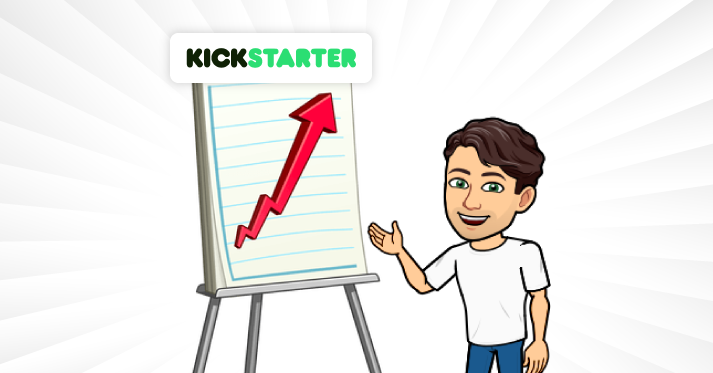A Basic Guide To Getting Started On Kickstarter

Ever wonder how entrepreneurs, inventors, artists, and filmmakers find the money to bring their creative ideas to life? Gone are the days of submitting 100-page business plans to investors. The answer is crowdfunding.
Crowdfunding websites, like Kickstarter, have quickly become an essential avenue for projects to get off the ground. In fact, Kickstarter reports they have pledged more than 6.2 billion dollars to over 200,000 projects since the start in 2009.
Do you have an idea that needs funding but are unsure where to start with Kickstarter? We put together this guide to help you run a successful Kickstarter campaign!
What is Crowdfunding?
Crowdfunding uses social media and websites to get small amounts of funding from a large number of individuals to finance a new business venture.
These websites bring investors and entrepreneurs together by expanding the traditional pool of owners, relatives, and venture capitalist investors.
What is Kickstarter?
Kickstarter
The most popular crowdfunding site, Kickstarter, helps aspiring businesses reach a larger audience to raise capital. However, it’s only for projects that can be shared with others.
Acceptable Project Categories
These projects usually fit into the following categories: art, comics, crafts, dance, design, fashion, film & video, food, games, journalism, music, photography, publishing, technology, and theater.
What is Considered a Project?
Kickstarter defines a project as something with “a clear goal that ultimately will be completed, and something will be produced by it.”
That means projects can’t be open-ended or something that requires ongoing maintenance.
What is Not Allowed on Kickstarter?
Kickstarter cannot be used:
- to fundraise for a charity/cause
- to offer equity, revenue sharing, or investment opportunities
- for any prohibited items such as “any item claiming to diagnose, cure, treat, or prevent illness or condition,” political fundraising, drugs or alcohol, or any contests, gambling, raffles. etc. (please see website for complete list)
Starting your Kickstarter Account
First things first, make sure you meet all the creator requirements to run a Kickstarter campaign. If so, let’s get started!
Start Early
Launching your Kickstarter campaign is the most significant step you can take. However, beginning your drive for funding doesn’t (and shouldn’t) happen overnight.
We recommend giving yourself at least two weeks to a month in advance before launching. This gives you plenty of time to make sure you are 100% ready.
Important tip! Be sure to take into account the time needed to be approved by Kickstarter’s review process. While they strive to have a 24-hour turnaround time, sometimes they get bogged down with submissions that push reviews out to a week.
Create your Kickstarter Profile
To get started on Kickstarter, you will need to create a user account. It only requires your name, email, and password.
Some tips on setting up your profile:
- Take some time to upload a picture, write a biography, and fill out the other information in your Kickstarter profile. All of this information helps others make a personal connection with you!
- Many people set up a personal account. However, there’s an option to create a profile for your company. The advantages of using your company include making projects more official, reputable, and dependable. But it can make it harder to create a human, emotional connection with the Kickstarter community.
Launching your Kickstarter Campaign
There are several moving parts when it comes to creating your Kickstarter campaign. As we said above, give yourself time to develop a strong campaign.
Choosing your Project’s Image
Your project’s image is the single most crucial branding element of the success of your project. It’s most likely the first thing potential backers will see, so it’s essential to make the best first impression. Use an image that’s eye-grabbing, attention-getting, and that represents your project well.
Kickstarter recommendation: photo dimensions should be at least 640×480 pixels and a 4:3 aspect ratio.
Choosing your Project’s Title
When creating a title for your project, approach it like you would a blog post. You want something that makes potential backers want to know more!
Setting a Funding Goal
We aren’t going to lie; this can be one of the most challenging parts of getting your Kickstarter project ready to launch. Here are some things to consider when thinking about your monetary goal:
- All-or-nothing: Kickstarter uses an all-or-nothing model when it comes to funding. That means you can only redeem the pledges backers make if you meet or exceed your goal.
- Cost of the project: You need to raise enough money to develop your project and fulfill all the rewards.
- The 20% Threshold: According to Kickstarter, 10% of campaigns ended without any pledges. However, 78% of projects that raised more than 20% of their goal were successfully funded.
Establishing your Campaign’s Deadline
While a Kickstarter campaign can run for up to 60 days, your project may not benefit from going the max amount of time. Statistics show that projects lasting 30 days or less have a higher success rate.
Why? Kickstarter accredits the success of shorter times to creating urgency, motivating backers, and instilling confidence in you to develop a solid push to your goal.
Creating Effective Rewards
A traditional investor would more than likely want equity in your company. With Kickstarter, backers receive rewards in exchange for their financial pledges.
Kickstarter rewards are usually something tangible, like a product from your campaign. They also can be in the form of a creative experience or a collaborative role in the project.
Some examples of the types of rewards that can be offered are:
- Thank you on your website
- The first copy of a book/software/album (whatever your item is!)
- Invitation to a movie screening (again, depending on what your project is)
Kickstarter allows you to offer different tier levels of rewards. Therefore, you can have different reward options for someone who donates $20 as compared to someone who donates $500.
Some tips for creating rewards:
- Be sure your rewards and levels are easy for potential backers to understand.
- Consider offering a special bonus for those who pledge early — this generates a sense of urgency.
Tell your Story
Filling out the project description and making a video are your opportunities to help others see why your project is important and why you need their help. (While videos are optional, we can’t recommend them enough to relay your story!)
Creating your Video
Here are our top tips for creating a powerful Kickstarter video:
- Introduce yourself – Opening your video by letting viewers know a little bit about you helps them connect with you…and your project!
- Get straight into a summary of your project. You don’t want to lose your viewer’s interest before you explain what your project entails!
- Be sure to cover your project’s benefits and features.
- Have a strong call-to-action at the end; tell viewers what you want them to do next.
Writing your Project’s Description
Your project’s description allows you to dive into all the details about your project. Keep in mind, people will most likely skim through and focus on what they’re most interested in.
Your description should include:
- Why do you need the money, and how it will be used
- Any concerns or issues that may arise
- How your project will come to life
- How the project works
- Rewards you are offering
- FAQ’s
Ready to Submit
Once you have completed all the required information, you are ready to submit your project! Click on the “send to review” button and take a deep breath!
When your project has been approved, you will have to launch it when you are ready manually. To do this:
- Click on “I’m ready to launch.”
- You will then be prompted to read the Terms of Use, Privacy Policy, and Kickstarter Rules
- Click the checkbox to acknowledge you read both.
- Next, click on the “Launch Project” button
- Congratulations, your project is now live!
(You should be redirected to a confirmation page and get a confirmation email)
Final Thoughts
Though it takes time and patience, using Kickstarter to fund your project can have many benefits. Now that you have a better understanding of how the crowdfunding site works, get out there and chase your dreams!
If you have questions or are looking to enhance your marketing, reach out to us marketing experts at Firon Marketing.


